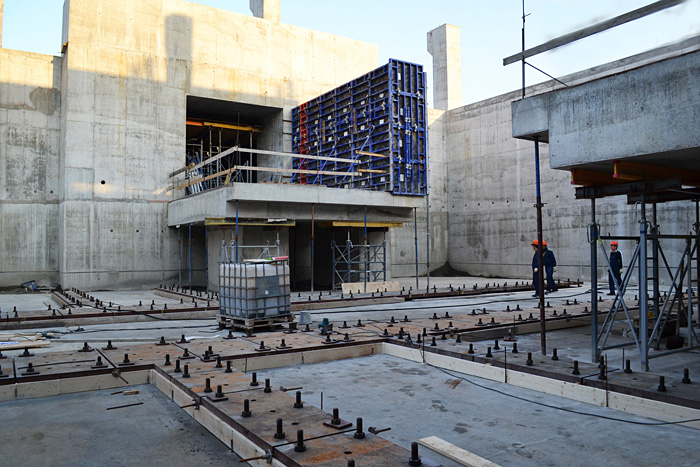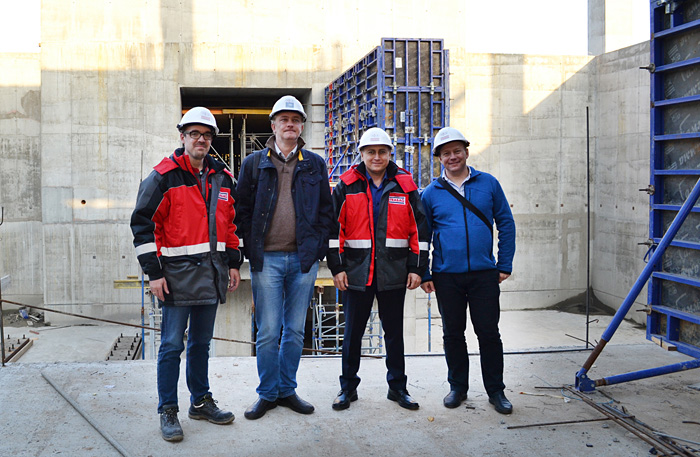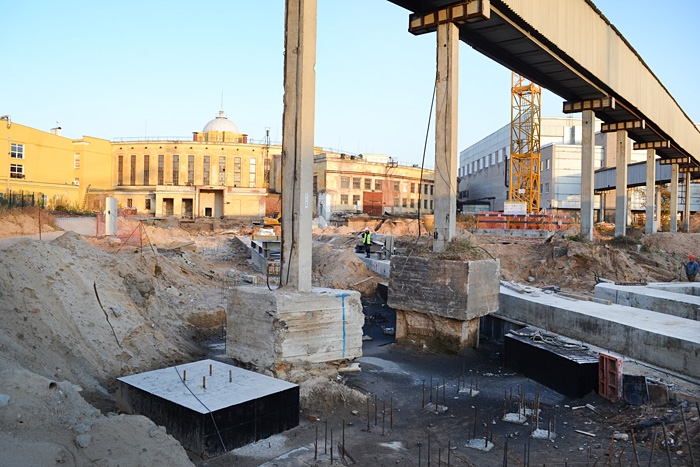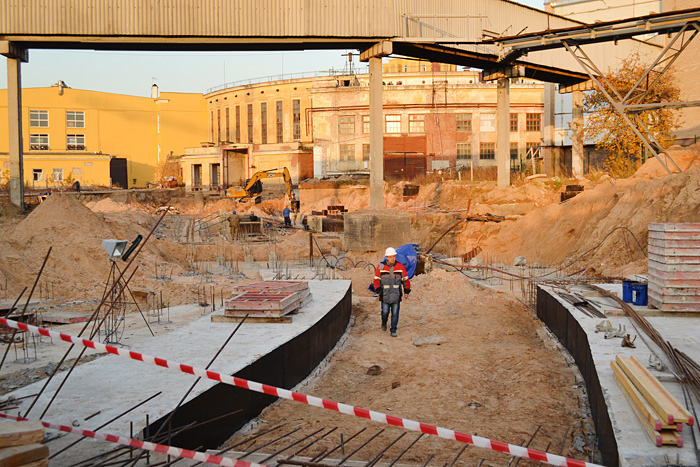At the NICA construction site
News, 06 November 2018
The report by the JINR Weekly Newspaper
In spite of the fact that changes in pictures taken from the surveillance cameras set up at the NICA construction site can be barely seen, it has significantly changed since our last report made half a year ago.
Moreover, pictures taken by a quadcopter allow us to observe how the counters of the project were just outlined, the building’s perimeter was traced, the walls of tunnels and pavilions raised, and floors were constructed. Now, these concrete buildings are being covered with the frame of metal structures. Work is already underway throughout the construction site, including the place of the junction of the beam transportation channels with the Synchrophasotron building. It is already possible to enter the hall where the MPD detector will be located through the collider tunnel, and the contour of the SPD building is getting more visible.
Observation of the NICA construction site was commented on by Deputy Head of JINR Chief Engineer Andrey Dudarev, Deputy Head of the JINR Capital Construction Department Yuri Balandin, Head of the Project from the party of the general constructor CJSC “Strabag” Ulrich Weinmann, Engineering System Project Manager Musabeg Magomedov.
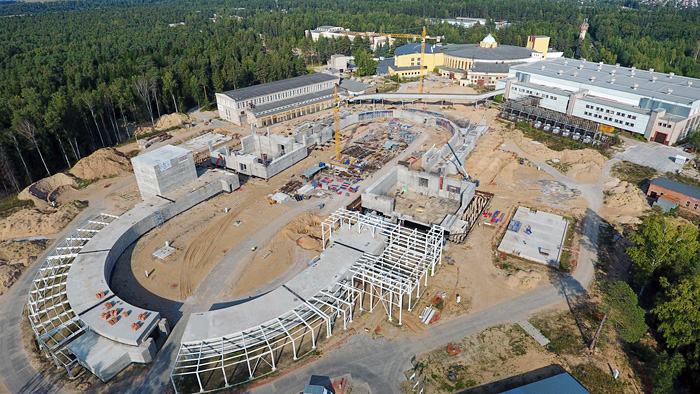 Photo taken from a quadcopter: Konstantin Shevchenko, Boris Golovensky
Photo taken from a quadcopter: Konstantin Shevchenko, Boris Golovensky
MPD is a priority field
The pavilion for the MPD detector consists of two rooms: in the upper part, there will be a hall where the arriving equipment will be unloaded, unpacked and stored. The second room will be the pit in which the MPD detector will be installed. An 80-ton crane will be used in the pavilion for the assembly of the physical equipment.
This is one of the most important parts of the project; particles will be registered here, and thus precision of the facility and stability of the equipment’s placement will directly influence the quality of the experimental data.
– The MPD pavilion is at the stage of completion concrete works, – Ulrich Weinmann notes. – Additional embedded parts, metal sub-rail slabs have been installed, at which rails for moving the detector will be assembled later. Firstly, a reinforced concrete slab was poured, anchors were installed in it, and sub-rail slabs were mounted on them with high accuracy. At this stage, we closely cooperate with VBLHEP Deputy Chief Engineer N.D. Topilin. The slope of the floor of the room should not exceed 2 mm by 14 meters horizontally. Moreover, the drop between the metal embedded slabs is practically not allowed, although the limit of 0.1 mm is specified. Shielding of the building has also been completed. This month, reinforced concrete work at MPD will be fully completed. This week, we will begin assembly of the metal frame of the MPD pavilion.
Waterproofing works were carried out on the external side of the pavilion. Our first reports began with the description of difficulties caused by the proximity of groundwater and protection of objects from its influence. Trenches, drainage, installation of a groove, installation of drainage pumping stations…
– The groove can be still seen from under the ground, – Andrey Dudarev says. – Thanks to this groove the counter of the trench was created, and then piles were driven into the ground. Originally, the groove was supposed to be extracted after completion of the pavilion construction; however, the decision was then made that the groove will be an additional obstacle for ground water. One more protection means from surface groundwater is a clay retainer. It is a 1-1,5 meter layer of clay with water-proof properties; it was delivered from a clay pit of the Vladimir Region. Thus, there are four levels of protection: waterproofing, drainage, the groove, and the clay retainer.
At the same time, work in the SPD pavilion is underway in the same sequence. According to the project, the SPD detector is still at the stage of the concept development, and this part of the construction runs its course. Now, pouring of walls is almost completed; it is planned to prepare piles for the frame, carry out all preparatory works, make shielding, the clay retainer, and etc.
Yuri Balandin and Musabeg Magomedov spoke in detail about the assembly of metal structures which is one of the most large-scale works at the moment. After the tender, a large order for production of metal structures was made. The items began to be shipped to the construction site, and in the shortest time, they are assembled in order not to create cramped conditions with stored details. A frame of metal structures is built around concrete buildings, which will be covered with sandwich panels and separated by internal partitions. Thus, all technical rooms will be created in which the equipment of engineering and technological systems will be located: ventilation, electric control systems, water-cooling systems, power sources, vacuum equipment, high-frequency systems, and etc. The total volume of metal structures will be 2100 tons; now 25 % has been assembled.
The most difficult site
Constructors remind that the project has an official name “Installation of the heavy ion collider NICA at the site of VBLHEP JINR in Dubna with a partial reconstruction of the building #1”. Now, the reconstruction has been launched. The first step is to reinstall the existing buildings and nets that are located at the construction site. Earlier, it was impossible to be done as far as due to the plan physicists were supposed to carry out research at the Nuclotron beams until the end of 2017, so the premises were used for carrying out runs.
It is planned to demolish one staircase and a part of the portal, in which there was the main entry in building #1. It seems like there is not so much to do, but a separate entrance was constructed from the opposite side of the building instead of that that will be reconstructed.
Then, one more important stage comes: to provide junction of new tunnels for beam transportation to the Synchrophasotron building. “If we consider the construction plans, at this site there are massive underground concrete buildings with communication lines in addition to the utility networks; it is also necessary to take into account preparation to the winter as far as high-tech equipment of JINR is stored in the reconstructed building,” M. Magomedov said. Another difficulty is that designers can provide the final construction plans for this site only after the results of dismantling works.
Special attention was paid to the cable tray system that crosses the construction site connecting the 208 and 1A buildings. A range of additional works was made to strengthen the foundation. The tray stands at piles, some of which are located at the spots where the tunnel of the NICA collider will be placed. To take such piles away the tray should by strengthened beforehand to avoid its fall.
The priority of this step of work is the same as that of MPD – it is needed for physicists as fast as possible because the equipment ordered in Europe is in the highest degree of readiness.
Several facts about progress of construction:
- Tender is now held on engineering systems for implementation of works on construction of electrical substations and cable lines.
- Tender on carrying out roof work was held, and the winner was chosen. Tender on facade works is almost finished.
- At present, about 150 builders are engaged in the construction. It is enough for today to carry out works in accordance with the documentation. Sheet metal workers will soon join us.
- A significant work was done to make changes and adjustments to the NICA project; that is why today General Designer the CJSC “Cometa” is preparing documents for the second expert review at Glavgosekspertiza (the Main Department of State Expertise) due to numerous changes that have taken place in the project since 2013.
Galina Myalkovskaya,
Photos by the author
